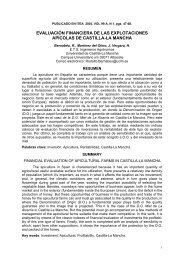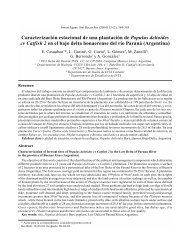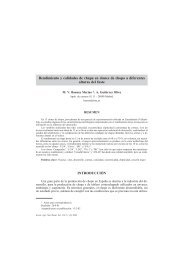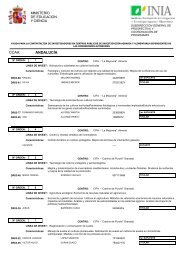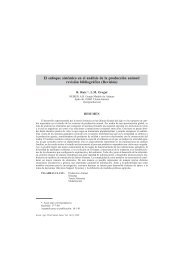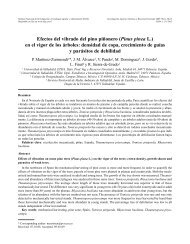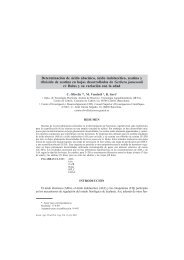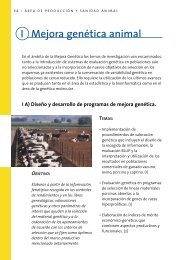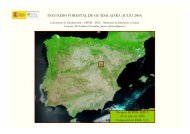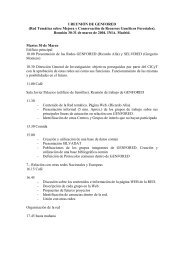Status of medicinal and aromatic plants in - Inia
Status of medicinal and aromatic plants in - Inia
Status of medicinal and aromatic plants in - Inia
Create successful ePaper yourself
Turn your PDF publications into a flip-book with our unique Google optimized e-Paper software.
PRESENTED PAPERS 123<br />
Table 1. Yield, number <strong>and</strong> length <strong>of</strong> primary branches <strong>and</strong> canopy width <strong>in</strong>tervals <strong>and</strong> frequencies (F)<br />
<strong>of</strong> a caper (Capparis sp<strong>in</strong>osa L.) population<br />
Yield<br />
(g)<br />
F<br />
(%)<br />
No. <strong>of</strong><br />
primary<br />
branches<br />
F<br />
(%)<br />
Primary<br />
branch length<br />
(cm)<br />
F<br />
(%)<br />
Canopy<br />
width<br />
(cm)<br />
0 8 5< 4 50-80 24 100< 1<br />
11-30 71 5-10 87 80-110 40 100-150 20<br />
31-50 11 >10 9 111-150 32 151-200 45<br />
51-60 5 >150 4 200-250 32<br />
61-80 4 >250 2<br />
>80 1<br />
F<br />
(%)<br />
The germ<strong>in</strong>ation rate for untreated caper seeds is quite low. Some seed treatments were<br />
tested to <strong>in</strong>crease germ<strong>in</strong>ation. Freshly harvested seeds <strong>of</strong> the year 1999 germ<strong>in</strong>ated at 29%<br />
when immersed for 12 h <strong>in</strong> 2000 ppm GA 3 . In control seed lots the germ<strong>in</strong>ation rate was<br />
only 1% (Fig. 3).<br />
35<br />
30<br />
25<br />
20<br />
15<br />
29<br />
28<br />
21<br />
26<br />
22<br />
1999<br />
1998<br />
11<br />
10<br />
5<br />
0<br />
1<br />
2 2<br />
1 1 1<br />
0<br />
5<br />
Control<br />
Soak<strong>in</strong>g<br />
H2SO4 (20%)<br />
H2SO4 (40%)<br />
GA3 (2000 ppm)<br />
GA3 (3000 ppm)<br />
GA3 (4000 ppm)<br />
Fig. 3. Effect <strong>of</strong> different seed treatments on germ<strong>in</strong>ation <strong>of</strong> caper (Capparis sp<strong>in</strong>osa L.) seed lots.<br />
Oregano (Origanum onites L.)<br />
The effects <strong>of</strong> three levels <strong>of</strong> nitrogen application (0, 60, 120 kg/ha) <strong>and</strong> four different<br />
plant<strong>in</strong>g patterns on Origanum onites L. were <strong>in</strong>vestigated for three years (between 1991 <strong>and</strong><br />
1993) <strong>in</strong> three locations. Green herb <strong>and</strong> drug leaf yield <strong>and</strong> essential oil percentage were<br />
measured. Yields <strong>and</strong> essential oil percentage were generally highest at 45 x 15 cm with an<br />
application <strong>of</strong> 60 kg/ha nitrogen (Table 2).<br />
Table 2. The effects <strong>of</strong> four plant<strong>in</strong>g patterns <strong>and</strong> three nitrogen levels on green herb <strong>and</strong> drug leaf<br />
yields <strong>and</strong> essential oil percentage <strong>of</strong> oregano (Origanum onites L.)<br />
Green herb yield<br />
(kg/ha)<br />
Drug leaf yield<br />
(kg/ha)<br />
Essential oil<br />
(%)<br />
Plant<strong>in</strong>g pattern<br />
45 x 15 cm 26520 5210 2.93<br />
70 x 10 cm 23320 4580 2.96<br />
22.5 x 30 cm 25570 5170 2.91<br />
25 x 20 cm 25070 4880 2.89<br />
N level<br />
N 0 24060 4800 2.93<br />
N 60 25270 4990 2.97<br />
N 120 26030 5100 2.88




